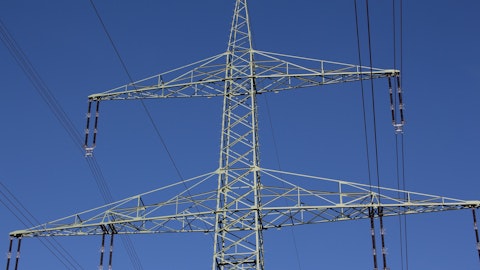In this article, we discuss the 10 biggest utility companies in the world. If you want to skip our detailed analysis of the utility sector, go directly to the 5 Biggest Utility Companies in the World.
According to a 2018 report by McKinsey and Company, the demand for utilities is at an all-time high and is growing to unprecedented levels. Electricity has superseded all other kinds of energy with value pools rising a brisk 4 percent a year, or €235 billion, in the decade leading up to 2025. The sector is steadily emerging as one of the more lucrative investment opportunities, with the IEA (International Energy Agency) estimating that a whopping $7.2 trillion will be invested into the sector in the decade leading up to 2025, conclusively lending a stable financial shape to the utility sector.
According to a report by Bloomberg, Navigant Research has forecasted that within the next decade, ten countries will emerge as the leading players in the global utilities-scale sector, namely the United States, China, Germany, the United Kingdom, France, Australia, India, South Korea, Brazil and Japan, accounting for more than 80% of the global market. The research firm, in a report from 2019, has estimated the increase of energy storage systems 1242.1MWs of new capacity. The report further noted that there has been an emergence of new markets and applications, which drove the global utility sector to its largest fiscal year on record in 2018.
According to the BP Statistical Review of World Energy 2021, the utilities sector is dominated by China, which leads the world in energy generation, followed by the United States. The State Grid Corporation of China is the largest utilities company in the world by revenue, and second largest company by revenue overall, right behind Walmart. Moreover, the review states that this might be owing to the fact that China leads the world in energy consumption, consuming up to 7779.1 terawatt hours.
However, according to an analysis by McKinsey and Company of over 50 global utilities, it was revealed that an average total cumulative return to shareholders of just 1 percent was delivered from July 2007 to July 2017, with many losing value. The report identifies three primary reasons for this predicament, namely the overcapacity and low wholesale prices in mature markets; a brisk rise in renewables in countries like Germany and France, which have resulted in stability challenges on existing networks; and the rise of new competition from other sectors, predominantly the oil and gas industries. Furthermore, the fact that barriers to entry are witnessing their lowest ebb ever, owing to digitalization, market liberalization, and the emergence of new entrants, does not help the financial crisis of the global utilities sector.
The Future of Utilities Sector
A study conducted by the Massachusetts Institute of Technology conducted an in-depth analysis into the future of the utilities sector and concluded that as the world moves towards a low-carbon future, companies which choose to compete within the accompanying transition changes hold the highest chances of profitability.
Some of the most well-known utility companies in the world include NextEra Energy (NYSE:NEE), Reliance Industries Limited (NSE:RELIANCE) and Shell plc (NYSE:SHEL). However, in this list, we shall only be going through the 10 biggest utilities companies in the world, by their respective market cap.
Biggest Utility Companies in the World
10. American Electric Power (NYSE:AEP)
Market Cap As of June 17: $45.4B
Headquartered in Columbus, Ohio, American Electric Power (NYSE:AEP) is one of the biggest investor-owned electric utility companies by revenue in the United States, offering its services to more than five million customers in over 11 states. It is also considered one of the largest generators of electricity in the nation, owing to its generation capacity of 38,000 MWs. The company also owns the nation’s largest electricity transmission system, spanning over a 39,000 mile network which includes 765 kilovolt ultra-high voltage transmission lines; this is more than all other U.S. transmission systems combined. With multiple subsidiaries over numerous states, American Electric Power (NYSE:AEP) ranked 185th on the Fortune 500 list of the largest United States corporations by revenue.
American Electric Power (NYSE:AEP), in the year of 2020, was able to generate a mammoth revenue of $8.879 billion with an operating income reaching up to only $1.507 billion. With assets worth around $80.757 billion, American Electric Power (NYSE:AEP) owns the Donald C. Cook nuclear power plant and is expanding its green efforts to include more International DuaStar hybrid diesel trucks. The company has a dividend yield of 3.04% with a profit-to-equity ratio standing firm at 19.68, making it one of the biggest investor-owned electric companies by profit-to-equity ratio in the U.S.
In its Q1 2022 investor letter, ClearBridge Investments Value Equity highlighted American Electric Power Company, Inc. (NYSE:AEP). Here is what they had to say:
“About 5% of the portfolio is in transitioning power companies, typically migrating from coal to renewables. We have been active in encouraging these transitions and added a new position in American Electric Power (NYSE:AEP). AEP (NYSE:AEP) has the fastest planned renewable energy ramp in the U.S., with plans to both shrink coal and grow renewables by 50% each by 2030. This would drive an 80% emissions reduction, while supporting high single-digit earnings growth at a double-digit return.”
9. National Grid plc (NYSE:NGG)
Market Cap As of June 17: $46.24B
Based in London, United Kingdom, National Grid (NYSE:NGG) is a British multinational electricity and gas utilities company, and it is next on the list of the 10 biggest utilities companies in the world. Its primary operations are based in the United Kingdom, where National Grid (NYSE:NGG) owns, maintains and operates natural gas and electricity transmission networks. Furthermore, it also operates transmission lines in the Northeastern region of the United States, providing electricity and natural gas to customers in New York, Massachusetts and Rhode Island.
With an annual revenue of ₤2.926 billion in the fiscal year of 2021, and total assets worth more than ₤67.216 billion globally, the National Grid (NYSE:NGG) is one of the largest investor-owned utility companies in the world, with a primary listing on the London Stock Exchange. With a total of 23,683 employees nationally, National Grid (NYSE:NGG) is also one of the largest companies in the world by market capitalization. As of 2022, it has a profit-to-equity ratio of 20.03, and a steady dividend yield of 4.22%.
Here is what ClearBridge Investments Cap Growth Strategy has to say about National Grid plc (NYSE:NGG) in its Q4 2021 investor letter:
“National Grid (NYSE:NGG) is one of the world’s largest publicly owned utilities, focused on transmission and distribution activities in electricity and gas. National Grid (NYSE:NGG) performed strongly during the quarter as the business continued to de-risk following prior regulatory decisions and significant M&A. The company also benefited from falling real rates, a solid set of half-year results and strong Investor Day presentations.”
Hence, like NextEra Energy (NYSE:NEE), Reliance Industries Limited (NSE:RELIANCE) and Shell plc (NYSE:SHEL), National Grid (NYSE:NGG) has proved to be one of the more dominant forces in the utilities sector today.
8. Enel S.p.A (BIT:ENEL)
Market Cap As of June 17: $57.89B
Headquartered in Rome, Italy, Enel S.p.A. (BIT:ENEL) is an Italian multinational manufacturer and distributor of electricity and gas, and is the largest utilities company in Europe by market capitalization. First established as a public body in 1962, Enel (BIT:ENEL) was privatized in 1999 following the liberalization of the Italian electricity market. However, the Italian state is the primary shareholder of the company with a 23.6% share in the company stakes. With €88 billion in revenue in 2021, Enel (BIT:ENEL) became the 73rd largest company in the world by revenue. It is also the second largest power company in the world by revenue, after the State Grid Corporation of China. Its total equity stands at €42.4 billion, giving it a profit-to equity ratio of 19.02 and a dividend yield of 6.21%.
Enel’s (BIT:ENEL) production of electricity is dependent upon a variety of renewable sources like geothermal, wind power, solar power, hydroelectric power, thermal and nuclear power. Enel (BIT:ENEL) has generated a total of 232 TWh of electricity, distributed 510.3 TWh, and sold 309.4 TWh in 2021. Enel (BIT:ENEL) is also concerned with research and development for the manufacturing and transmission of electricity, their activities ranging from the design and implementation of hybrid plants that conglomerate the use of different sources for energy storage in order to achieve maximum efficiency, to the development of smart grids that enhance sustainability of electrical transmission and production.
7. Dominion Energy Inc. (NYSE:D)
Market Cap As of June 17: $59.56B
Headquartered in Richmond, Virginia, Dominion Energy Inc. (NYSE:D) supplies electricity in parts of Virginia, North Carolina, and South Carolina, and provides natural gas to parts of Utah, West Virginia, Ohio, Pennsylvania, North Carolina, South Carolina, and Georgia. It also has generation facilities in Indiana, Illinois, Connecticut, and Rhode Island. As of 2015, eighteen percent of Dominion’s (NYSE:D) electricity production was generated from coal, twenty-two percent from nuclear power, nine percent from oil, twelve percent from hydro-electric sources and thirty-two percent from natural gas, while the remaining seven percent was generated via other sources. In keeping with the transitional changes of the utilities sector, Dominion (NYSE:D) is currently developing a strategy to acquire and use renewable energy sources, primarily wind and biomass, procuring conservation and efficiency programs to meet future demand, and sustaining their corporate social responsibility by actively working towards minimalizing the Dominion’s (NYSE:D) environmental footprint.
According to their first quarterly report of 2022, with over 22,000 employees, Dominion (NYSE:D) was able to secure a revenue of over $16.572 billion, with their operating income levelled at just below $2.514 billion. Their total assets are worth more than $103.823 billion, with their asset portfolio including 27,000 megawatts of power generation, 6000 miles of electric transmission lines, 54,000 miles of distribution likes, 14000 miles of natural gas transmission and 1.3 trillion cubic feet of natural gas and oil reserves. Dominion Energy Inc. (NYSE:D) operates the country’s largest natural gas storage facility. Furthermore, the company serves more than 5 million retail energy customers in the mid-Atlantic, Midwest and Northeast regions of the United States, and are listed at number 238 on the Fortune 500 list.
6. Iberdrola (BMAD:IBE)
Market Cap As of June 17: $64.60B
Based in Bilbao, Spain, Iberdrola (BMAD:IBE) is a multinational renewable electric utility company and is the second largest producer of wind power by revenue and by market capitalization. With over 45,000 employees across Europe serving over 31.67 million customers, Iberdrola (BMAD:IBE) has subsidiaries in numerous countries namely Spain, the United Kingdom (Scottish Power), the USA (AVANGRID) , Brazil (NeoEnergia), Mexico, Germany, Italy, Portugal and France. It generated an annual revenue of $39.11 million in the fiscal year of 2021. Furthermore, Iberdrola (BMAD:IBE) has a dividend yield of 2.78% and a profit-to-equity ratio of 16.91.
With total assets marked at €123 billion, Iberdrola (BMAD:IBE) has reported having and operating installed capacity of 55396 MW producing a total of 42,951GWh in the year of 2021, during which their clean energy capacity boomed from 13.3% to 79%, making it one of the more consistent efforts towards clean energy by a European utility company. They have increased their investments in renewables by 29%, projecting themselves as one of the most lucrative investment opportunities in the year of 2022.
Click to continue reading and see the 5 Biggest Utility Companies in the World.
Suggested Articles:
- 10 New Stocks Reddit’s WallStreetBets is Buying
- 15 Best Real Estate Stocks for 2021
- 25 Most Corrupt Countries in the World
Disclosure. None. 10 Biggest Utility Companies in the World is originally published on Insider Monkey.





